Dana Duxbury-Fox
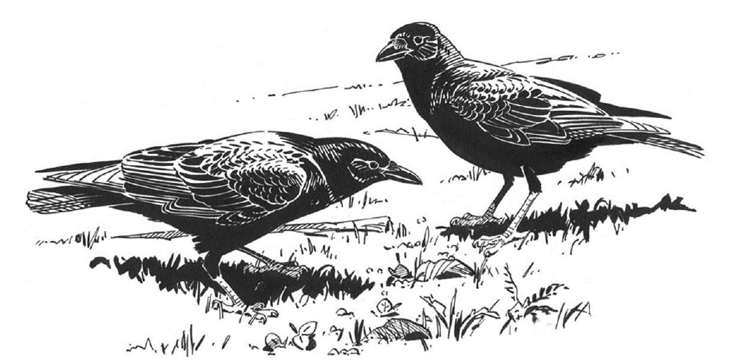
American Crows. Illustration by Barry Van Dusen.
"If men had wings and bore black feathers, few of them would be clever enough to be crows." Reverend Henry Ward Beecher
American Crows (Corvus brachyrhynchos) and Fish Crows (C. ossifragus) traditionally roost communally in winter. Across their range, many of these roosts have been in existence for a number of years. Very large roosts tend to occur in regions where there is abundant food, and also where northern migrants augment resident crow populations, as in Oklahoma (Good 1952).
Communal roosting by large numbers of crows is not well understood. Sibley (2001) offers some explanations:
Some evidence indicates that information about profitable foraging areas may be passed on at roosts; hungry birds follow well-fed ones to better feeding sites the next day. Another explanation is that the birds gather near reliable feeding areas, where they can be sure to get something to eat first thing in the morning and again at the end of the day. Large roosts may also offer protection from predators and the comfort of converging at warm, sheltered spots.
In Massachusetts, maximum numbers of crows are recorded in October and March, and many crows are seen during hawk migrations. High counts include 1,000+ in Berkshire County on October 22, 1950; 1500 in Needham on October 30, 1979; and 1175 in Ashburnham on October 27, 1979. In spring, high counts include 700+ in Dartmouth on March 23, 1958, and 600 flying north at Plum Island, on March 15, 1993 (Veit and Petersen 1993).
Early History of Winter Roosts
The most famous early account of a crow roost was by Alexander Wilson in his American Ornithology (1811). He described a roost that occurred in the late 1700s that
is near New Castle, on an island in the Delaware. It is known by the name of Pea Patch, and is a low, flat, alluvial spot of a few acres, elevated but little above high-water mark and covered with a think growth of reeds....It is entirely destitute of trees, the crows alighting and nestling among the reeds…
The colony was once destroyed by a tide that flooded the island during "a sudden and violent northeast storm." Wilson continued: "This disaster, however seems long to have been repaired, for they now congregate on the Pea Patch in as immense multitudes as ever."
Some reports of roosting crows over the past 200 years sound uncannily like the descriptions of contemporary crow roosts. Dr. John Godman in his Rambles of a Naturalist, wrote of his observations in 1825 of a roost at his home in Anne Arundel County, Maryland:
The Roost is most commonly the densest pine thicket that can be found, generally at no great distance from some river, bay or other sheet of water which is the last to freeze, or rarely is altogether frozen. To such a roost the crows which are, during the day time, scattered over perhaps more than a hundred miles of circumference, wing their way every afternoon and arrive shortly after sunset. Endless columns pour in from various quarters, and as they arrive pitch upon their accustomed perches, crowding closely together for the benefit of the warmth and shelter afforded by the thick foliage of the pine. The trees are literally bent by their weight, and the ground is covered for many feet in depth by their dung, which by its gradual fermentation must also tend to increase the warmth of the roost. Such roosts are known to be thus occupied for years, beyond the memory of individuals….(Godman 1833)
In the winter of 1916–1917, Charles Townsend MD explored a vast American Crow roost at Castle Hill in Ipswich, Massachusetts, and later wrote detailed descriptions of the roost. At that time, 20 or 30 acres of land at Castle Hill were covered with mature evergreens, mostly European scotch and Austrian pines, and patches of deciduous trees.
He noted that by 3:00 pm, three streams of crows began their flight to the roost, gathering first in the dunes or in the fields below the hill. An hour later, he and his companions saw a flock stretching for two miles that took four minutes to pass their observation point. Sunset was at 4:15 that day and it was dark when many of the birds finally went into the evergreens to roost. He calculated that there were 12,000 birds in the roost (Townsend 1918).
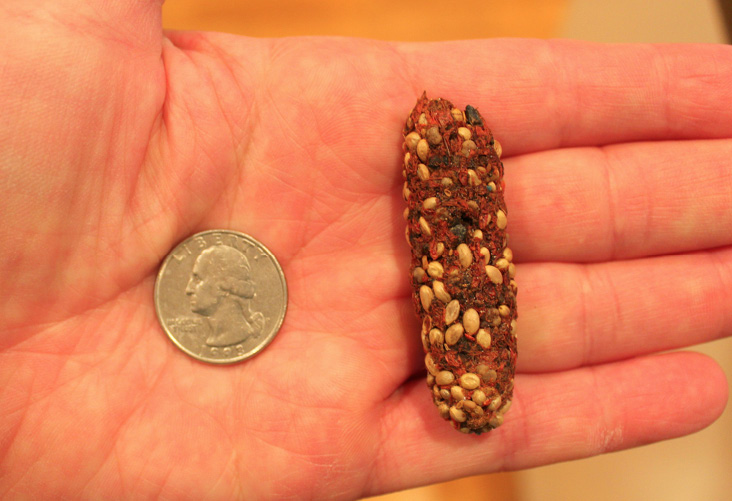
Crow pellet found at the Lawrence Winter Roost. All photographs by Craig Gibson.
Townsend was fascinated by the pellets of indigestible material that the crows disgorged. He collected many pellets from the Castle Hill roost and had them analyzed by the U.S. Biological Survey. Analysis determined that the pellets contained mainly bayberry seeds, along with seeds of poison ivy, staghorn sumac, cranberry, and barberry. (Townsend 1918). A similar pellet analysis from the Lawrence roost is currently being conducted by Dr. Tom French at the Massachusetts Division of Fisheries and Wildlife.
The Lawrence Winter Crow Roost
In the winter of 1989, Eliot W. Taylor first reported American Crows roosting in downtown Lawrence, Massachusetts, a seemingly unlikely location. Lawrence is a city of only six square miles in area, and the Merrimack River, which bisects the downtown area, is lined with many former brick textile mills. The year this roost was established is unknown, but Taylor first noticed the roost on February 2, 1989, when he was driving along Interstate 495, which runs through Lawrence. He saw many crows flying across the road headed into the city and thought, "There must be a roost." He promptly turned off the highway and followed the crows to a cemetery where he estimated 2000 crows (Taylor, personal communication). On other visits to the roost, he reported 4000 crows (Forster et al. 1990), 8000 crows (Forster et al. 1993), and 11,500 crows (Kellogg et al. 2007).
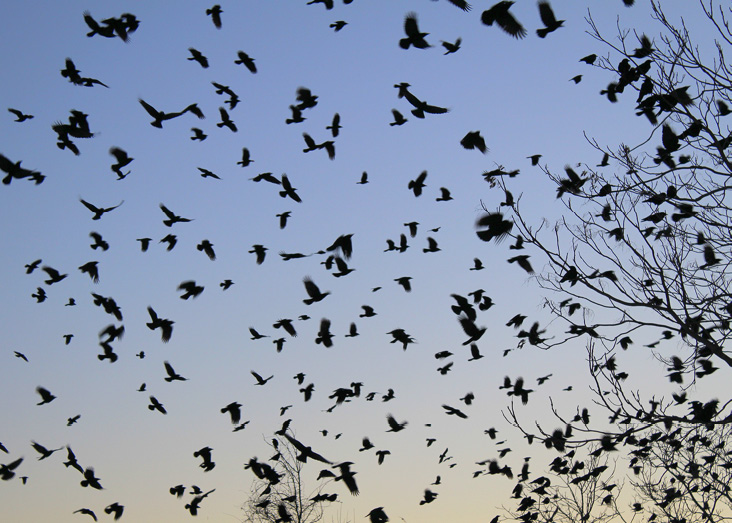
Just after sunset on December 28, 2017, hundreds, if not thousands, of crows pour into a staging area on the west side of the O'Leary Bridge Rt. 28/Broadway by the Great Stone Dam.
Joseph Hogan of Lawrence also reported winter roost numbers to Bird Observer: 5272 crows (Forster and Rines 1992) and 4256 crows (Forster et al. 1994). Rick Heil reported 10,000–15,000 crows in 2009 (Kellogg et al. 2009).
The Lawrence roost also contains flocks of Fish Crows, which are easily identified by their nasal calls. Before heading to the roost, Fish Crows tend to settle into staging areas in various parking lots separate from American Crows. Skip Charette reported the first Fish Crow at the Lawrence roost on January 13, 1994 (Forster et al. 1994).
There have been no recent documented estimates of the total number of American and Fish crows coming into the Lawrence roost. I observed 5000 American Crows on November 16, 2017.
Staging
Prior to entering a winter roost, crows usually fly in small flocks from their daytime feeding areas to one or more staging areas during the afternoon. Most arrive at staging areas that are one or more kilometers from the roost an hour before sunset (Moore and Switzer 1998). On cloudy or windy days, they often start flying earlier. Crows do not appear to do much, if any, feeding in the staging areas.
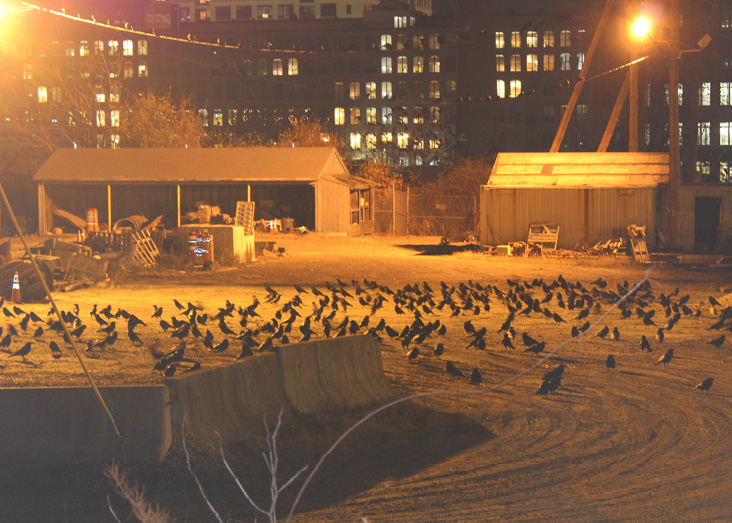
The National Grid substation on South Canal Street is one of the crows' staging areas. Crows cover the ground, fill the trees, and perch on the utility wires.
Interestingly, crows that are members of cooperative breeding groups—usually many of the permanent resident crows—leave the feeding area independently, do not roost together, and independently leave the roost in the morning (Caccamise et al.1975).
Staging may have evolved to deter persecution and to help keep the roost location secret. Once at the staging area, the crows are social and noisy, with flocks periodically rising and moving to a new spot. At the staging area, the crows may feed, preen, and scan the surroundings (Moore and Switzer 1998). We also have observed some crows going into an almost stupor-like behavior prior to going to roost, as well as at the actual roost. This behavior was particularly noticeable on cold winter days. The birds seemed oblivious to nearby people and hardly moved for long periods of time even when settled on the ground. Unfortunately we are unable explain this interesting behavior.
Staging areas are usually different almost every night. In Lawrence, crows start to pour into the city along the Merrimack River from all directions about an hour before sunset on a winter day. It is a breathtaking experience watching the crows stream in against the background of old textile mills, factories, telephone wires, and lights. They appear immune to the fact that they are settling into a bustling city. No one knows for sure how far away the crows come from. Each night, they seem to choose a different staging area either to the east or the west of their final roosting spot. Every night is like a "Where's Waldo" puzzle. If it is very cold and the river is frozen, many crows will gather to the west of the roost on the ice above the Great Stone Dam. Or they might go to Pemberton Park on the northwest side of the roost. Other nights they may stream to the east of the roost and gather on either the south or north side of the river—in trees, in parking lots, on buildings, and on the ground. One cloudy night, we found them on the hill to the east of the Lawrence General Hospital. The noise is always considerable. There is constant movement of swirling flocks around the staging area.
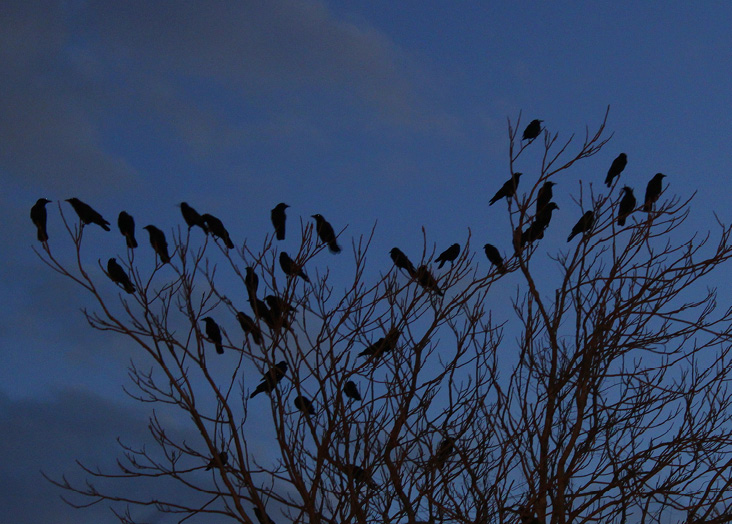
Silence falls when the crows settle into their overnight roost.
The Roost
Once it is dark, usually half an hour after sunset, the crows enter the roost. In some places, crows may use the same roosting site for many years (Emlen 1938, 1940; Black 1941). The total number of birds in a roost varies from a few hundred to more than 500,000 (Gorenzel and Salmon 1992) to 2,000,000 (Iams 1972). Sometimes, crows settle in such high density that the limbs of the roost trees break.
Crows often roost in coniferous trees. In Lawrence, there are no stands of conifers along the Merrimack River, so the crows use the riverine deciduous trees. They roost either in a line of 30-foot-tall silver maples along the south side of the Merrimack River bordering the New Balance property on South Union Street, or in silver maples or birch trees on the north side of the river. After dark, the lights of the evening shift at the factory illuminate the trees, which appear to be decorated with a thousand black ornaments. Suddenly it is quiet.
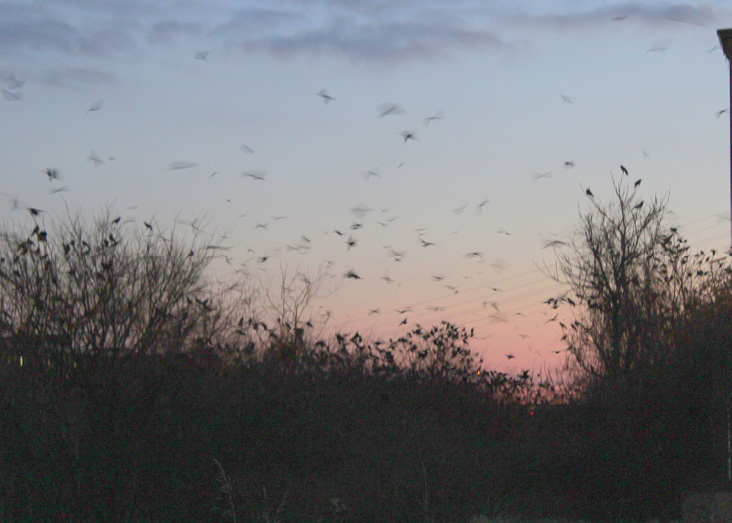
Crows leave the roost before sunrise, flying over the Merrimack River.
Departure from the Roost
At sunrise, crows depart from the roost and go out to feeding areas for the day.
But just an hour before sunrise, when the east was becoming faintly lighted, the crows suddenly commenced awakening, and at the same time commenced cawing. The few who led the measure were within one or two minutes joined by the full chorus of 300,000 or more voices, each apparently striving to be heard by all the rest. Never before had I realized the almost infinite possibility of the crow's variable caw in the production of discords. This great noise, which the poetic soul of Audubon conceived to the "thanksgiving" and "consultation," was kept up for twenty minutes before any movement was discernible. (Edwards 1888)
Exploring and Viewing the Lawrence Roost and Staging Areas
Plan to visit the roost on an afternoon any time from November through March. The number of birds will be highest in January and February. Dress warmly, as you will want to have the car windows open. A flask of coffee or tea also can be helpful. Check the time of sunset and plan to arrive at least an hour before. A sunny afternoon is best.
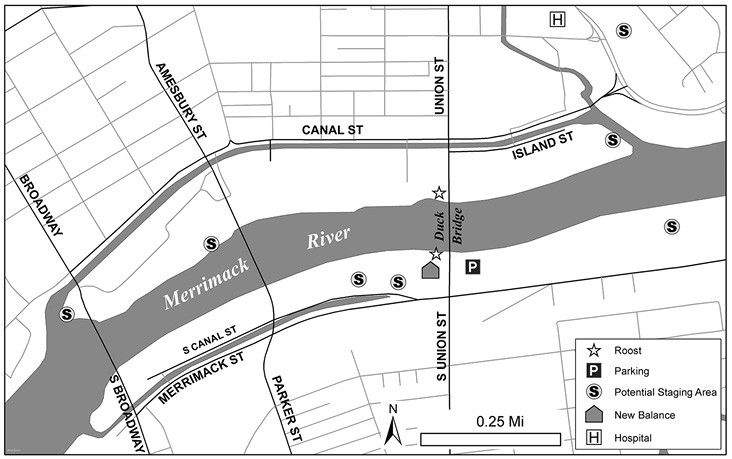
Map of Lawrence Roost and Staging Areas.
To reach the roost, take Interstate 495 to Lawrence and get off at Exit 44. See the map for potential staging areas and for the roost and New Balance factory sites. Travel along Merrimack Street from east to west looking for the gathering flocks. Turn into the parking lot of 280 Merrimack Street and drive to the river. Scan along both sides of the river for gathering crows. If they are along the north side of the river, view them by returning to Merrimack Street and take a right onto South Union Street, then go over Duck Bridge and take your first right onto Island Street. Follow Island Street to the east around the buildings until you reach a parking lot along the river. Look for crows on a small grassy hill (Ferrous Hill), on rooftops, in parking lots, or in the trees along the river. You can return to Duck Bridge (South Union Street) at any time to watch the crows enter the roost.
If the crows are not gathering on the east side of South Union Street, continue along Merrimack Street, crossing South Union so that the New Balance shoe factory will be on your right. Turn onto a dirt road, South Canal Street, just beyond the factory and park your car along the fence. They may be staging at the National Grid and the adjoining truck trailer parking lots. Drive farther along Merrimack, as crows may be scattered on both sides of the road along wires, on rooftops, and in parking lots. Listen to the crows, as you may come across a gathering of Fish Crows. The crows may be in Pemberton Park on the north side of the river between the Parker Street and South Broadway bridges. If the river is frozen, drive farther west and turn right—north—on South Broadway, passing over the bridge; look west over the Great Stone Dam on the ice and in the trees bordering the river.
Half an hour after sunset, the crows will take off in small groups and fly to the north and south sides of the river along South Union Street. Park in the New Balance parking lot on the east side of South Union and walk across the street and out onto the bridge. Once you get to the edge of the New Balance shoe factory, look down into the trees lining the river. Crows, like large black baubles, will be adorning the trees and more crows may still be joining the roost. Walk quietly and slowly along the bridge and you will see the tree branches hanging over the river adorned with more black baubles. Now walk across the bridge and look at the north side in the trees bordering the river—thousands and thousands of crows. You are left to hazard your own guess as to how many!
You may also choose to view the departure of the crows from the roost. This will be more dramatic and very noisy. Arrive an hour before sunrise and follow the directions in the previous paragraph. Stand in the middle of the bridge to watch the crows erupt from the trees on both sides of the river.
Other Roosts in Massachusetts
Currently, there are known large roosts in Framingham and Springfield. American and Fish crows are also known to roost on Martha's Vineyard each night, returning to the mainland to forage during the day.
Crows and their communal winter roosts are fascinating. I encourage readers to visit one to experience the sheer spectacle—the whir of wings, the raucous calls, and the aggregation of thousands of resident and migrant birds against the setting or rising sun.
Addendum
After the February 2018 issue of Bird Observer went into production—about a month after this article was written—the crows in Lawrence disappeared from their traditional roost site near the New Balance factory on South Union Street. On December 27, 2017, Craig Gibson discovered them staging on the frozen Merrimack River to the west of the South Broadway Street Bridge and the Old Stone Dam. After sunset, the crows moved to a new roost site in Pemberton Park on the north side of the river between the South Broadway Bridge and the Casey Bridge off of Amesbury Street. Bob and I visited the staging site around 3:30 pm on Friday December 29, where Bob counted 7,500 crows on the ice and 1,200 crows in the trees lining the river. We followed the stream of crows to their new roost after dusk and every tree along the river and many trees in the parking lot were filled with crows. On January 3, we found the crows roosting in another spot—14,000 of them—in trees on the south side of the river to the west of the dam in the Lawrence Water Treatment plant's parking lot.
Due to the frigid weather of the last weeks of December 2017 and the beginning of January 2018, the Merrimack River had frozen upstream of the Old Stone Dam and the extent of the ice was greater than usual. Perhaps the new roost locations are temporary in response to the extreme cold and the frozen river, and the crows will return to their former roost when winter conditions return to normal. We will continue to monitor the staging and roosting sites of the Lawrence crows.
Acknowledgements
Over the past few years, Wayne Petersen's infectious curiosity and enthusiasm for crows and the Lawrence crow roost, coupled with my characteristic ability to immerse myself in a subject once I get started, along with the generous help of so many friends and other birders, especially my husband Bob Fox, Craig Gibson, and Barry Van Dusen, led to this article. Special thanks go to Craig Gibson, who has become a passionate crow observer and photographer par excellence of the city's crows; and to Jim Berry, who provided me with early records and helped to edit this piece.
References
- Black, C. T. 1941. Ecological and economic relations of the crow, with special reference to Illinois. Ph.D. dissertation University of Illinois, Urbana.
- Caccamise, D. F., L. M. Reed, J. Romanowski, and P. C. Stouffer. 1997. Roosting behavior and group territoriality in American Crows. The Auk 114:628-637.
- Edwards, C. L. 1888. Winter Roosting Colonies of Crows. The American Journal of Psychology. Vol.1 (3): 449-450.
- Emlen J. T. Jr. 1938. Midwinter distribution of the American Crow in New York State. Ecology. 19: 264–275.
- Emlen J. T. Jr. 1940. The midwinter distribution of the crow in California. Condor 42:287–294.
- Forster, R.A., G. W. Gove, and R. H. Stymeist. 1990. Field Records January/February 1990. Bird Observer 18 (3): 174.
- Forster, R. A., and M. W. Rines. 1992. Bird Sightings January/February 1992 Summary. Bird Observer 20 (3): 167.
- Forster, R. A., M. W. Rines, and R. H. Stymeist. 1993. Bird Sightings January/February 1993 Summary. Bird Observer 21 (3): 176.
- Forster, R.A., M. W. Rines, and R. H. Stymeist. 1994. Bird Sightings January/February 1994 Summary. Bird Observer 22 (3): 164.
- Godman, J. 1833. Rambles of a Naturalist. Philadelphia: Thomas T. Ash—Key and Biddle, p. 122.
- Good, E. E. 1952. The life history of the American Crow Corvus brachyrhynchos Brehm. PhD Thesis, Ohio State University, Columbus.
- Gorenzel, W. P., and T. P. Salmon. 1992. Urban crow roosts in California. Proceedings of the Vertebrate Pest Conference 15: 97–102.
- Iams, G. 1972. Fort Cobb crow study. Oklahoma City: Oklahoma Department of Wildlife Conservation.
- Kellogg, S., M. W. Rines, R. H. Stymeist, and J.R. Trimble. 2007. Bird Sightings January/February 2007. Bird Observer 35 (3): 191.
- Kellogg, S., M. W. Rines, R. H. Stymeist, and J. R. Trimble. 2009. Bird Sightings January/February 2009. Bird Observer 37 (3): 182.
- Moore, J. E., and P. V. Switzer. 1998. Preroosting aggregations in the American Crow, Corvus brachyrhynchos. Canadian Journal of Zoology 76:508-512.
- Sibley, D., C. Elphick, and J. B. Dunning, Jr. 2001. The Sibley Guide to Bird Life and Behavior. New York: Knopf.
- Townsend, C. W. 1918. A Winter Crow Roost. The Auk 35(4) 405–416.
- Veit, R. R., and W. R. Petersen. 1993. Birds of Massachusetts. Lincoln: Mass Audubon.
- Wilson, A. 1811. American Ornithology, Vol. IV, pp. 82–84. Philadelphia: Bradford and Inskeep,
At eight years old, Dana Duxbury-Fox asked for her first bird book and has been an active birder ever since. She graduated from Cornell University, and taught biology in India for two years. For many years, she has been researching ways to protect the Common Loon with the Loon Preservation Committee in New Hampshire. Now, winter crow roosts have caught her attention. Dana, her husband Bob, and Craig Gibson are continuing their research on the Lawrence Crow Roost.